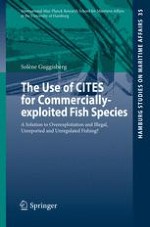2016 | OriginalPaper | Buchkapitel
Chapter 5 Protection of Commercially-exploited Fish Species Under CITES
verfasst von : Solène Guggisberg
Erschienen in: The Use of CITES for Commercially-exploited Fish Species
Aktivieren Sie unsere intelligente Suche, um passende Fachinhalte oder Patente zu finden.
Wählen Sie Textabschnitte aus um mit Künstlicher Intelligenz passenden Patente zu finden. powered by
Markieren Sie Textabschnitte, um KI-gestützt weitere passende Inhalte zu finden. powered by
